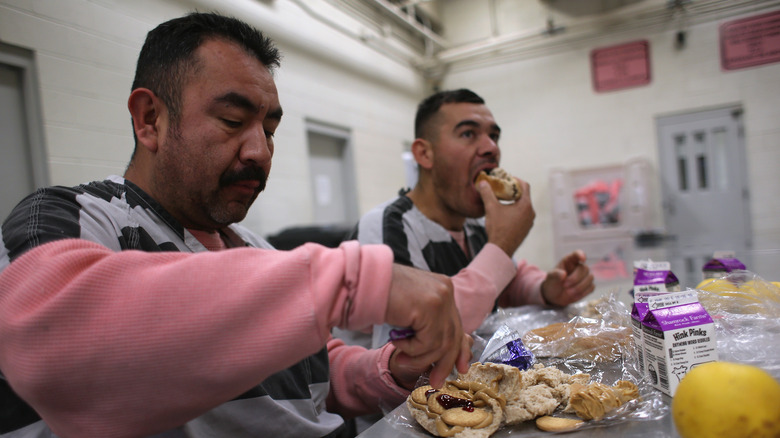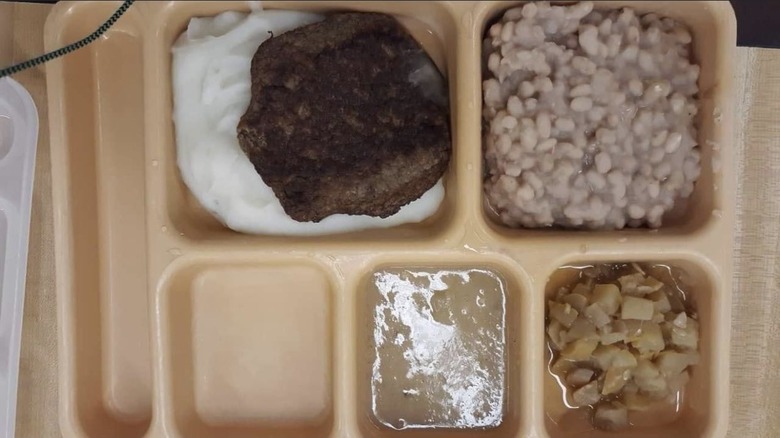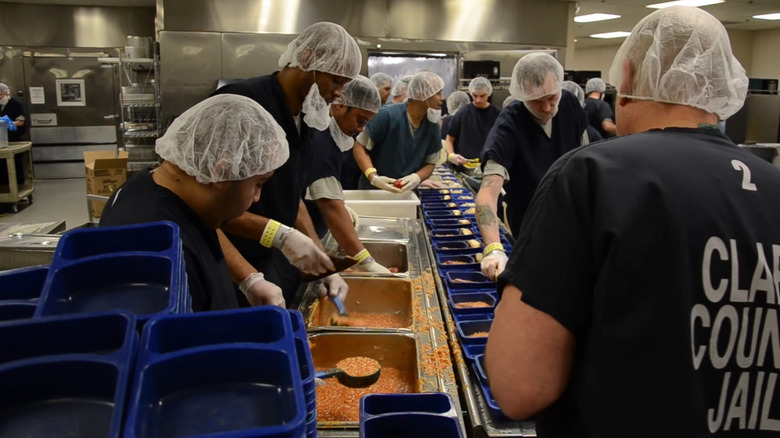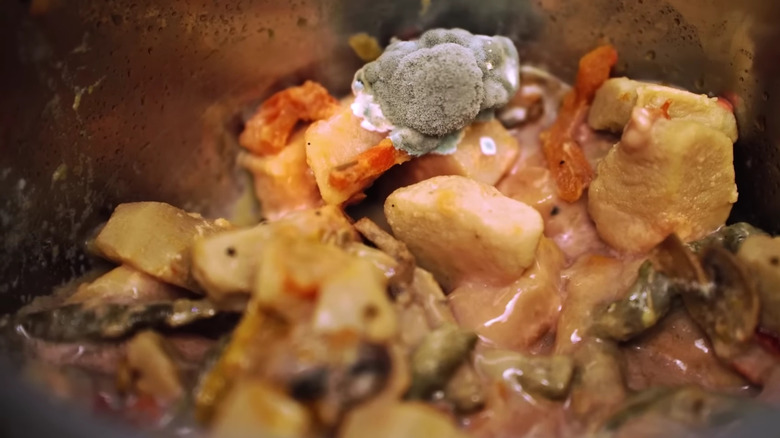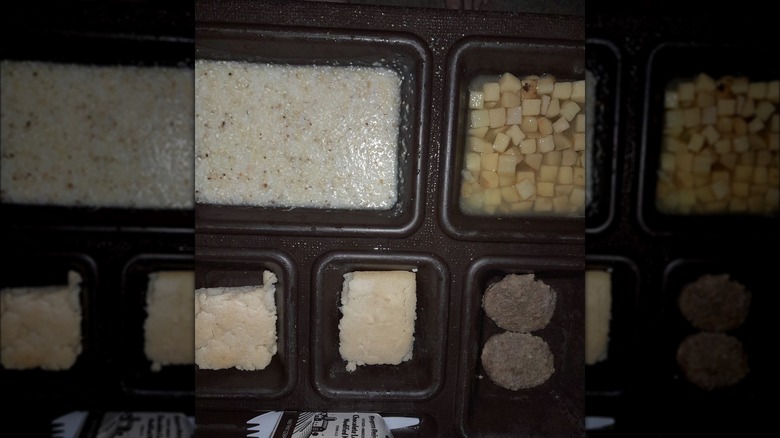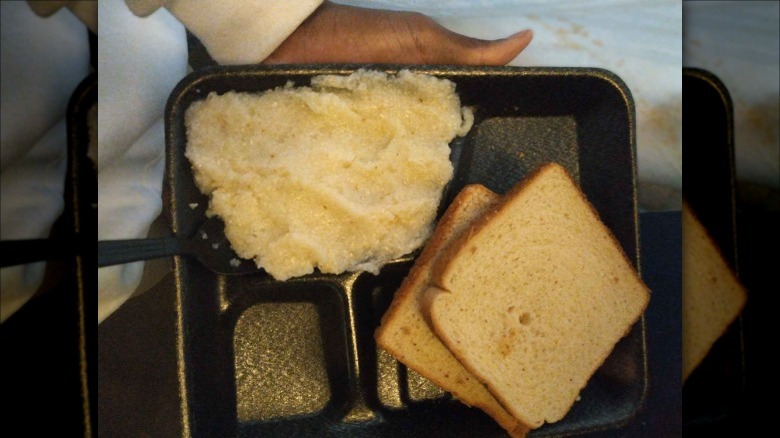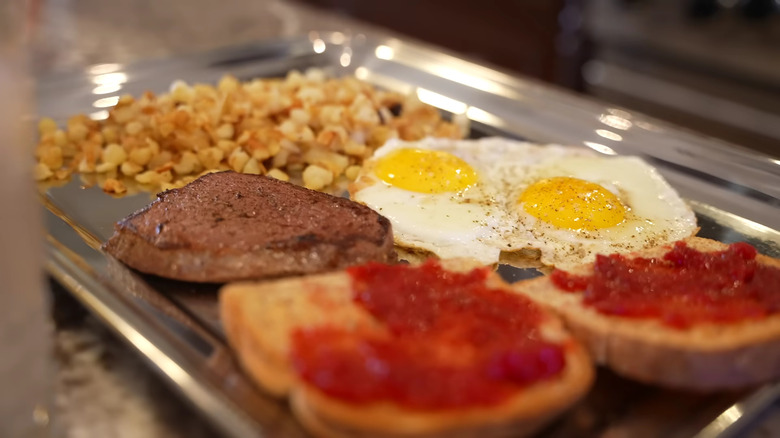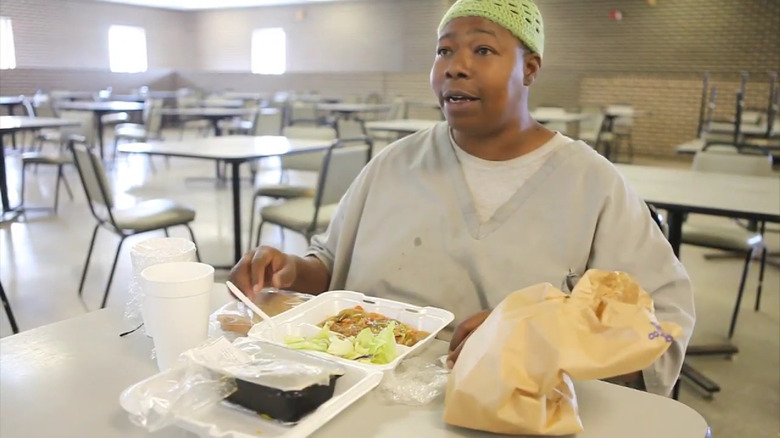What Prison Food Is Really Like Around The United States
In 2022, Prison Policy Initiative reported that there were nearly two million people incarcerated in the United States. These individuals are held in a variety of facilities including state prisons and local jails. The conditions experienced by these people vary widely across states and facilities. However, across the U.S., the consensus is that the food served in prisons is unhealthy, inadequate, and occasionally dangerous.
Many suggest that a key cause of poor prison diets is increased privatization as catering companies seek to maximize profit margins, often at the expense of quality. Consequently, food standards have fallen to shocking lows in many facilities across the nation. There have been reports of old, rotting food being served to inmates, as well as food that contradicts individuals' dietary requirements. In fact, some prison food is so bad that it's served as a form of punishment like the infamous "nutraloaf" served in some prisons.
Prisons have a legal obligation to provide inmates with a certain amount of nutrients and calories per day. Yet how facilities deliver these nutrients and calories is highly varied. In this article, we highlight some of the nationwide trends in prison food while also revealing how certain states and facilities are over- or underperforming. We'll warn you now: most of this doesn't make for pretty reading.
Nutraloaf is used as a punishment in some states
Nutraloaf is a baked loaf that's usually made from a hodgepodge of ingredients including carrots, spinach, and dried beans. The loaf is not a routine part of prison meals; instead, it is reserved for inmates deemed to be issues, such as those in solitary confinement. It is so disgusting that prisoners in numerous states have sued after being forced to eat it. Several states, like New York and Massachusetts, have even banned it.
Despite many states banning nutraloaf, some prisons still use the meal to punish inmates in solitary confinement. Labeled a special management meal, nutraloaf can be served to these individuals three times per day, for seven days straight. One day of regular meals is all that is legally required before an inmate can be put on another seven-day cycle.
Serving nutraloaf can have dramatic consequences. In Milwaukee, an inmate called Terrill Thomas died of dehydration after he was denied water and served nutraloaf for a week. The nutraloaf was reportedly so dry that dust from it set off the prison's fire alarm system. Sheriff David Clarke Jr. was running the prison at the time of Thomas' death. In an interview with NPR, he defended the use of nutraloaf, stating: "It's a food source; it contains all the vitamins and nutrients and minerals that a human being needs. It's been approved by the courts. I've had it myself — it's like eating meatloaf."
Many inmates have limited access to fresh fruit and vegetables
According to a 2020 report released by Impact Justice, the organization concluded that the majority of American inmates have limited access to fresh produce. In fact, 62.2% of respondents stated they rarely or never had access to fresh vegetables. 54.8% gave the same response when queried about fruit.
Not only are fresh fruit and vegetables extremely rare in prisons across America, but in some, they are even banned because inmates might brew alcohol using them. Fresh fruit and vegetables also cost more for catering companies to purchase, store, and prepare. As such, the majority of prison food is constituted of shelf-stable refined carbohydrates.
Inmates sometimes even smuggle fruit and vegetable seeds into prisons in an attempt to grow their own produce. Fortunately, some facilities, like Georgia's Central State Prison, have encouraged gardening. One prisoner noted that "A steady breakfast of grits, powdered eggs, and biscuits is made memorable when a big slice of cantaloupe or honeydew melon suddenly appears on the tray" (via Modern Farmer).
Food is often full of harmful bacteria
A study published in the American Journal of Public Health analyzed the number and severity of foodborne illness outbreaks in American correctional facilities from 1998 to 2014. Over this time, the median number of food poisoning cases was 45 per 100,000 inmates, six times higher than the rate suffered by American civilians. The reasons behind these outbreaks are varied, but they often stem from serving rotten food, including high-risk items like chicken.
Another significant cause of foodborne illness outbreaks is poor food hygiene. The same study found that C. perfringens, a bacteria, was the most common source of poisoning. This bacteria multiplies when food, such as poultry, is stored between 40 and 140 degrees Fahrenheit, as per the CDC. Poor practices such as this are reportedly commonplace in prisons, in part because inmates are not required to undergo food safety training or certification. Inmates may not be aware of the risks associated with certain culinary practices.
A majority of inmates report being served rotten food
There's little room to deny it: the vast majority of inmates incarcerated in facilities across the United States have been served rotten food. According to research conducted by Impact Justice, a shocking 75% of respondents said they had to contend with this issue. One inmate in an Orange Country prison sent a statement to Stop the Musick Coalition, writing: "Sometimes the bread comes moldy or soggy; we are pretty much starving [...] The milk sometimes comes sour, it expired, and yet they pass it out like that. Honestly, it seems that they don't care because at the end of the day they go home and eat fresh cooked meals [...] we stay here."
In Michigan, there have been numerous reports of maggots both in kitchens and in the food served to inmates. When maggots are discovered, surfaces are wiped, the offending food is binned, and the meal is resumed. In 2018, after numerous instances of rotten food, several Michigan prisons moved away from private catering companies and placed the kitchens under state control. Prison kitchens have since become cleaner, better staffed, and more able to serve food on time, according to officials who spoke with the Detroit Free Press.
Meals in Oklahoma and Arizona jails cost less than $1 to make
During the mid-2010s, sheriff Joe Arpaio of Maricopa County, Arizona made headlines when he boasted that prison meals served under his watch were the cheapest in America, costing between 15 to 40 cents to produce. Arpaio managed that in part by substituting all meat products for soy and serving two meals per day instead of three.
Although Arpaio lost his bid for re-election in 2016, jails in Maricopa County still serve up cost-saving food. In 2021, the only food inmates received on Saturdays and Sundays were two lunches that each included a single peanut butter and jelly sandwich, cookies, and a portion of fresh fruit. The "breakfast" meal also included an eight-ounce serving of milk.
Meanwhile, prisons in Oklahoma cut costs by serving starchy food like rice and biscuits. On average, prison meals in this state cost between 75 to 85 cents to produce. Zachary Starnes, an ex-inmate at Oklahoma State Reformatory, explained what it was like to eat this type of food: "Those meals, when you eat them a couple hours later, you're starving. A few hours later, those carbs are going to turn into sugar and you're not going to be full anymore" (via The Frontier).
A lot of prison food is fortified
As many prisons serve minimal amounts of fresh fruit and vegetables, fortified foods are often used to meet nutritional requirements.
According to Barbara Wakeen, owner of a company that provides nutrition consulting to prisons, "I'd like to see everybody get all of the food groups, but I know that in this environment it's not always possible. As a result, we have all these wonderful fortified things, we've got fortified beverages, there's fortified cake mixes and baking powders" (via The Guardian). These products are densely packed with nutrients. Cass County Jail in North Dakota serves a fortified beverage that provides an adult's entire daily requirement of vitamins C and D in one serving.
While fortified products provide essential vitamins and minerals, they also pose issues of their own. WebMD reports that fortified foods are highly processed and frequently contain unhealthy levels of sugar, salt, and fat. Ultimately, these fortified foods are seen as a poor substitute for natural, whole foods. As dietician Stacey Nelson told the Harvard Medical School, "Even if they're fortified, they still won't contain all of the nutrients a whole food source would."
Prison meals are high in sodium, saturated fat, and sugar
The United States incarcerated population is extremely unhealthy. A summary of scientific papers provided by the AAFP Foundation highlighted the range of health issues suffered by American prisoners, including mental illness, communicable diseases, and lifestyle-associated illnesses such as cardiovascular disease.
According to a study published in Circulation, inmates are at a much greater risk of developing hypertension and cardiovascular disease than the general non-imprisoned population. This trend may be attributable to the incredibly high levels of sodium consumed in prisons. The same study found that, when commissary items were included, prisons were consuming up to 6712 milligrams of sodium per day. That's over 400% more than what's recommended for most adults.
A study published in BMC Nutrition found that, when prison meals and commissary items were combined, the resulting diet exceeded recommended daily intake of sugar, saturated fat, and carbohydrates. These poor dietary practices are present in jails across the country, including in states like Georgia and South Carolina. As a result, an estimated 75% of American inmates are overweight or obese, while another 30% suffer from hypertension (via US Department of Justice).
Texas is looking to get rid of sack meals
Texas prisons have developed a bad reputation when it comes to food. In 2011, the Texas Department of Criminal Justice implemented a $2.8 million food cost reduction initiative across the state's prisons. Unsurprisingly, this led to a dramatic drop in the quality of prison meals. This decline reached rock bottom during the COVID-19 pandemic, when some inmates were locked in their cells for two weeks during an outbreak. The food they consumed during this time was predominantly sack lunches, including peanut butter sandwiches and single hot dogs wrapped in soggy slices of bread. Photos of this food taken by inmates and published by The Marshall Project caused an uproar.
Texas officials now say they will scrap these sack lunches by 2030 in favor of more nutritious alternatives and a culinary training program for inmates who are preparing and serving food. However, some advocates are skeptical. Prison policy expert Scott Henson told The Marshall Project that "The idea that by 2030 we might feed prisoners better food than pig slop is a wonderful thought. But the reality is that TDCJ's good intentions do not matter in the least."
Last meal rules vary
In any given prison, the majority of inmates are all served the same food (although differences are theoretically allowed for those with religious or dietary requirements). There is only one occasion when an inmate can get served exactly what they want: their last meal. The tradition of granting a prisoner on death row a final meal choice is a long-standing one, as when gladiators in ancient Rome were given feasts the night before combat.
Today, an American inmate's last meal is largely dependent on where they are held. In Oklahoma, inmates have a $25 spending limit. In Florida, it is $40, while inmates eating their last meal in Louisiana are joined by the prison warden. Texas abolished an inmate's right to a special last meal in 2011 after one prisoner ordered a huge feast that included two steaks, a pizza, and a burger. He ate none of it, leading politicians to decry the tradition of last meals and move to do away with the privilege.
Dietary requirements are often ignored
By law, prisons must provide food for those with dietary requirements, typically inmates who cannot eat certain foods for medical or religious reasons. Unfortunately, these laws are frequently ignored in practice. An inmate in New York reported that they were served gluten-rich foods despite having celiac disease. He stated that he was punished if he did not eat the food and suffered severe weight loss as a result.
In 2018, the Anchorage Correctional Complex was taken to court for serving Muslim inmates pork during Ramadan. The Council on American-Islamic Relations director, Lena Masri said that "The Constitution and Congress forbid prisons from compelling inmates to choose between their faith and food. We hope that a court will do what Anchorage Correctional Complex officials will ensure that Muslim inmates are not starved or forced to violate the principles of their faith during the holy month of Ramadan." (via The Independent).
Officials may be wary of these professions of belief for another reason. Alternative meals, such as those that are kosher, tend to be much more expensive to produce. Inmates may believe that kosher meals — which are usually made off-site — are of better quality than regular meals. Because of this, of the inmates who eat kosher meals, it's estimated that only one-sixth are actually Jewish.
Prison food is usually supplemented with commissary items
Meager portions, unappetizing food, and disregard for dietary requirements often cause inmates to go hungry. In between meals, there is only one source of food people can turn to: the prison commissary. Research conducted by Prison Policy Initiative found that incarcerated people in Illinois and Massachusetts spent about $1,000 a year on commissary items, often to supplement their meals. In Massachusetts, the average commissary expenditure was $1,207 per year, of which $940 was spent on food.
One of the most popular items is instant ramen. As cookbook author and ex-inmate Gustavo Alvarez told NPR, "You can use it to barter — it's worth a dollar [...] Also, it can bring a couple of guys who don't have much together. Why? Because maybe a guy has a bag of chips — that's all he has to his name. And this other guy is blessed to have a couple of soups. Well, they get together, they make an interesting meal."
Unfortunately, commissary products are just as unhealthy as the meals provided by prisons. A study published in the Journal of Correctional Healthcare found commissaries were full of foods high in refined carbohydrates, saturated fats, salt, and sugar. Fresh fruit or other healthy alternatives were difficult to find.
Prisons in Maine are a model for what prison food could be
Not all prisons serve atrocious food. In Maine, the Department of Corrections has implemented an initiative that sees inmates making a variety of wholesome food in the prisons themselves. Fresh produce is grown on-site, while the bread is baked in-house. This surprised Dan Giusti, founder of Brigaid. "The folks at Maine DOC are forward-thinking," he told the Portland Press Herald. "I was told they were good, but I was really shocked by the extent of what they're doing there. They make all their own bread – so much is made from scratch."
The program also helps inmates gain experience that can land them jobs once they have finished serving their time. This was celebrated by Randall Liberty, commissioner of Maine's Department of Corrections: "Ninety-five percent of these people will be released back in the community. And the question is, when they are released, are they better workers, taxpayers, family and community members than when they arrived? The work we're doing here absolutely gives them an opportunity to be successful" (per Portland Press Herald).
